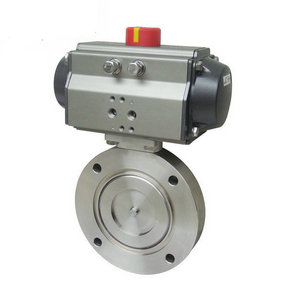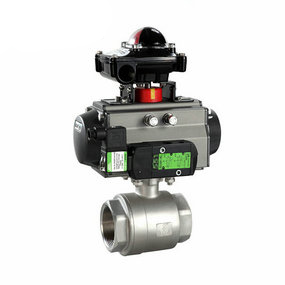How to adjust the leakage of pneumatic double butterfly valve? The surface morphology of the laser plasma sprayed coating is obviously different from that of the untreated substrate, indicating that the dominant wear mechanism is different. The surface layer of the wear scar presents obvious furrow characteristics, that is, the micro cutting process is obvious. At the same time, under the load, the abrasive grains press into the friction surface to produce marks, which extrudes the plastic material surface into layered or scaly peeling chips. Therefore, the coatings prepared by plasma spraying process are mainly abrasive wear. The appearance of flaky peeling and plastic deformation characteristics indicates that adhesive wear exists in the matrix, indicating that abrasive wear is no longer the main wear mode, which may be the combination of adhesive wear and fatigue wear when the matrix is paired with the original friction pair, and fatigue wear is the main wear mode.
2.3 Coating bonding strength and thermal shock performance The bonding strength and thermal shock performance of the coating and the substrate have an important impact on the operation of pneumatic ball valves under high temperature conditions. The bonding strength between Al2O3-TiO2 cermet coating and substrate is the highest, reaching 60.40MPa, while the bonding strength of WC Co cermet coating is only 39.45MPa. The internal porosity of the coating and whether the linear expansion coefficient of the coating and the substrate match are the main reasons affecting the adhesion of the coating. According to the test results, Al2O3-TiO2 cermet coating has the best bonding performance with the valve core ball. After 100 times of cold and hot cycles, the Al2O3-TiO2 cermet coating did not produce any obvious cracks and peeling, while the WC Co cermet coating appeared obvious cracks after 6 times and began to fall off after 8 times. Al2O3-TiO2 cermet coating has better thermal shock resistance than WC Co cermet coating due to its better linear expansion coefficient than WC Co cermet coating and substrate. 3 Conclusion 1) Both cermet coatings have high microhardness and small porosity, compact structure, no obvious cracks, and typical layered structure.
2) The wear resistance of the friction pair composed of cermet coating is significantly improved compared with the original friction pair. The wear mechanism of the coating friction pair is mainly abrasive wear; The matching of original friction pairs is mainly fatigue wear.
3) The experimental research on the wear resistance, microhardness, bonding strength and thermal shock resistance of the laser plasma spraying coating shows that the comprehensive performance of Al2O3-TiO2 cermet coating is better than that of WC Co cermet coating. Al2O3-TiO2 cermet coating can be used as the spraying coating for remanufacturing high-temperature pneumatic ball valve.

2、 The ways to reduce the dead weight of the pneumatic ball valve ball are casting thin wall ball and hollow ball abroad, and casting is also used in China, but the quality of the casting cannot pass the standard. Even if it is a qualified part, it is far from meeting the technical requirements of the ball quality. The other is the ball welded with multiple plates, but it is not suitable for batch production because of many welds and complex process. Our method is to replace the traditional welding method with the once forming technology of pipe cold extrusion for the sphere of DN 100. At present, there are also pipes for forming in China, but the traditional method they use abroad is the hydraulic expansion molding process, which is complex and inefficient. For the production of large balls, we have also found out a unique processing method, called plate forming process. With this method, the utilization rate of steel is up to more than 60%, almost double the original, the net weight of the ball after forming is reduced by more than 50%, and there is only one weld joint, which is located on an unimportant non matching surface. It is not difficult to see that the use of thin wall ball and hollow ball technology is not desirable. This not only improves the low-pressure sealing performance, but also extends the service life of pneumatic ball valves. At the same time, the metalworking hours are reduced by more than 2/3 compared with the original.




